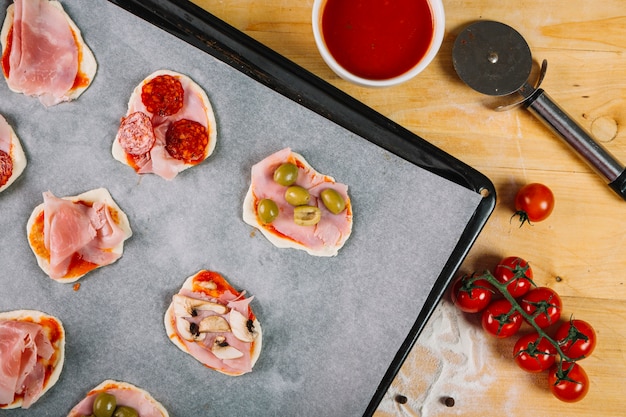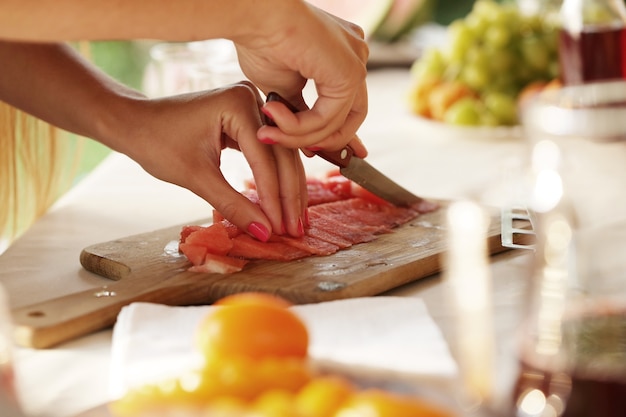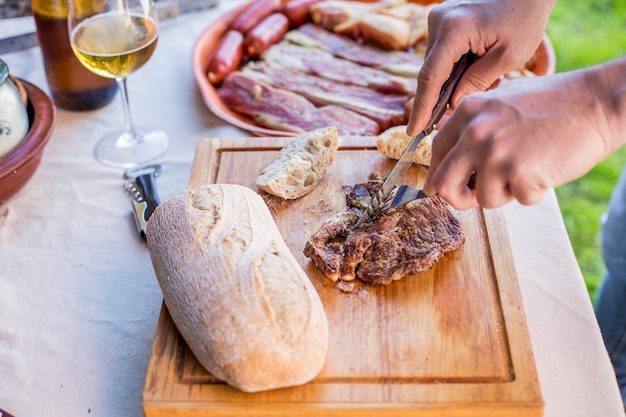Ah, bacon. Just the word evokes a symphony of sizzling, savory sounds and the aroma of pure, unadulterated deliciousness. For many, it's the undisputed king of breakfast, the ultimate topping for burgers and salads, and a delicious addition to countless dishes. But achieving that perfect, gloriously crispy bite can feel like a culinary quest, with the occasional floppy, undercooked piece leaving you feeling unsatisfied. Fear not, bacon lovers! I'm here to share my tried-and-true methods for crafting the most satisfying, crispy bacon, every single time.
This isn't just a recipe; it's a bacon odyssey, packed with tips, tricks, and personal anecdotes (because, let's be honest, life is better with a good story, especially when it involves bacon). So, grab your apron, your favorite pan, and let's embark on this delicious journey together.
(Part 1) The Bacon Basics: Setting the Stage for Success

choosing the right bacon: The Foundation of Flavor
Let's start at the beginning. Choosing the right bacon is crucial for achieving that perfect crisp. While I'm partial to thick-cut bacon – it's just more substantial, yielding those fantastically crisp edges – don't shy away from thinner cuts if you prefer. It's all about finding the right balance for your taste.
Here's the secret to understanding bacon: It's all about the fat content. Aim for bacon with around 20% fat – that sweet spot where you get both the satisfying crisp and the juicy flavor. Think of it as a delicious equation.
The Cold Start: A Trick from Grandma's Kitchen
Now, this is a little gem I learned from my grandma, and it's a game-changer. Always start with cold bacon. This might seem counterintuitive, but trust me, it's a crucial step. When you bring the bacon straight from the fridge to the pan, the fat renders more evenly, creating that glorious crisp. It's like giving your bacon a head start on its journey to crispy perfection.
The Right Pan: The Culinary Canvas
Choosing the right pan is like selecting the perfect canvas for your masterpiece. I've tried them all – cast iron, stainless steel, even nonstick – and my absolute favorite for bacon is a trusty cast iron pan. The even heat distribution and incredible heat retention are essential for that golden crisp. Plus, cast iron imparts a subtle flavor that adds an extra layer of deliciousness.
If you don't have a cast iron pan, a good, heavy-bottomed stainless steel pan is a fantastic alternative. Just make sure it's large enough to comfortably hold your bacon without overcrowding.
(Part 2) The Frying Method: A Classic Approach

For many, frying is the classic way to cook bacon, a method that delivers on those crispy, golden promises. It's simple, quick, and it's hard to beat the sound of bacon sizzling in a pan. Let's break down the steps to ensure success with this time-tested technique.
Step 1: Heat the Pan: Finding the Sweet Spot
We're aiming for medium-high heat here, not a blazing inferno. You want to find that perfect balance where the fat renders quickly but doesn't burn. Trust your instincts – if the pan seems too hot, lower the heat. You'll know it's ready when a tiny drop of water sizzles instantly when it hits the surface.
Step 2: Lay the Bacon: Spacing for Success
Gently place your bacon strips in the pan, making sure they're not touching each other. This ensures even cooking and proper airflow, preventing steaming instead of crisping. Don't overcrowd the pan – let the bacon breathe!
Step 3: Watch and Wait: The Art of Patience
Now, the fun part: Watch as your bacon sizzles and transforms. The fat will begin to render, creating a pool of golden goodness in the pan. Resist the urge to flip too soon. Let the bacon cook undisturbed for about 3-4 minutes, allowing the bottom to develop a beautiful golden brown crust.
Step 4: Flip and Finish: The Crucial Turn
Once the bottom is perfectly browned, use tongs to carefully flip each piece. Now, you're aiming for that same glorious browning on the other side. The bacon is done when it's a deep golden brown and feels crispy to the touch. This usually takes another 2-3 minutes, depending on the thickness of your bacon.
Step 5: Drain and Enjoy: The Final Touches
Finally, remove the bacon from the pan and drain it on a paper towel-lined plate. Let it cool slightly before serving. This allows the fat to solidify a bit, enhancing that satisfying crisp.
(Part 3) The Baking Method: A Hands-Off Approach

Now, I know what some of you might be thinking: "baking bacon? Isn't that just for wimps?" Hear me out. While frying is my go-to method, baking is a great alternative, especially if you're looking for a less messy option. It's also ideal for large batches, perfect for feeding a crowd.
Step 1: Prepare the Pan: A Clean Slate
Line a baking sheet with foil for easy cleanup. You can also use parchment paper, but I find foil to be more durable.
Step 2: Arrange the Bacon: A Single Layer of Perfection
Place the bacon strips on the prepared baking sheet in a single layer, making sure they're not overlapping.
Step 3: Bake it Low and Slow: Patience is Key
Preheat your oven to 350°F (175°C). This lower temperature allows the bacon to cook slowly and evenly, resulting in that gloriously crispy bacon we crave. Bake for about 20-25 minutes, flipping the strips halfway through. You'll know it's ready when the edges are crispy and the fat has rendered out.
Step 4: Drain and Serve: The Moment of Truth
Remove the bacon from the oven and let it cool slightly on a paper towel-lined plate. This will help the bacon crisp up even further.
(Part 4) The Air Fryer Method: A Modern Twist
Ah, the air fryer – a culinary marvel, a modern-day bacon whisperer. It's fast, efficient, and delivers those ridiculously crispy results with a fraction of the mess. Here's how to master this method.
Step 1: Preheat the Air Fryer: Get Ready for Action
Preheat your air fryer to 400°F (200°C).
Step 2: Arrange the Bacon: Space is Essential
Place the bacon strips in a single layer in the air fryer basket, ensuring they're not overlapping.
Step 3: Cook Until Crispy: The Air Fryer's Magic
Cook for 5-7 minutes, depending on the thickness of your bacon and your desired level of crispiness. Remember to check on the bacon halfway through and flip the strips to ensure even cooking.
Step 4: Drain and Serve: The Air Fryer's Delight
Remove the bacon from the air fryer and drain on a paper towel-lined plate. Let it cool slightly before serving.
(Part 5) Tips and Tricks for the perfect bacon: Elevating Your Game
Now, let's delve into those little secrets, the tips and tricks that elevate your bacon from good to exceptional.
Don't Overcook: The Danger of Burnt Bacon
Overcooked bacon is a culinary tragedy. It becomes dry, brittle, and frankly, unappetizing. Keep a watchful eye on it, and remove it from the pan or oven just when it reaches that perfect level of crispiness. You want it to be firm but still have a hint of chewiness.
Use a Spatula: A Tool for Precision
A good spatula is your bacon-cooking sidekick. It helps you flip those strips with ease, preventing breakage. Look for a spatula with a flexible blade that can slide under the bacon without snagging.
The Paper Towel Trick: Absorbing Excess Fat
This is a real game-changer. Once your bacon is cooked, place a few paper towels over the strips while they're still hot. The paper towels will absorb any excess fat, making your bacon even crispier.
Don't Discard the Fat: bacon fat's Versatility
Don't throw away that bacon fat! It's a culinary goldmine. Strain it through cheesecloth or a fine-mesh sieve to remove any bits of bacon. You can use it to sauté vegetables, make gravy, or even add a delicious flavor to your mashed potatoes.
(Part 6) Creative Uses for Bacon: Beyond the Ordinary
Now that you're a bacon master, let's explore the endless possibilities for using this versatile ingredient. From classic breakfast staples to unique flavor combinations, bacon is a culinary chameleon.
Beyond the Breakfast Plate: Exploring New Frontiers
Bacon isn't just for breakfast! Here are some ideas to get your culinary creativity flowing:
- Burgers and Sandwiches: Elevate your burgers and sandwiches with a few strips of crispy bacon. The salty, savory flavor adds a delicious dimension.
- Salads: Sprinkle some crumbled bacon on top of your favorite salad for a textural and flavor boost.
- pasta dishes: Chop up some crispy bacon and add it to your pasta dishes for a satisfying crunch and a burst of flavor.
- Soups and Stews: Crumble cooked bacon into your soups and stews for a rich, smoky depth.
- baked potatoes: Top your baked potato with a generous amount of crispy bacon for a satisfyingly comforting meal.
Desserts, You Say? Bacon's Sweet Side
Yes, you heard that right! Bacon can even be incorporated into desserts. Here are a couple of unusual, yet surprisingly delicious, ideas:
- Chocolate-Covered Bacon: Dip strips of bacon in melted chocolate and let them cool on a baking sheet. The salty and sweet combination is a delightful contrast.
- Bacon-Infused Ice Cream: Add a few pieces of crispy bacon to your homemade ice cream recipe for a unique and unexpected flavor twist.
(Part 7) The Bacon Connoisseur's Table: A Deeper Dive into Flavor
For those who truly appreciate bacon, there's a whole world of varieties and flavor profiles to explore. Let's delve into the fascinating world of different types and flavors.
types of bacon: A Spectrum of Choices
There's a bacon for every taste. Here's a quick guide to some popular types:
| Type of Bacon | Description |
|---|---|
| streaky bacon | The most common type, made from the belly of the pig. It has a high fat content, giving it a rich, savory flavor. |
| back bacon | Cured from the loin of the pig, back bacon is leaner than streaky bacon, offering a slightly more delicate flavor. |
| smoked bacon | This bacon is smoked over wood chips, giving it a distinctive smoky aroma and flavor. |
| Canadian Bacon | A type of back bacon that is cured and smoked. It is usually sliced thinly and has a mild, sweet flavor. |
Flavours of Bacon: Adding a Touch of Spice
Beyond the classic bacon, there's a whole spectrum of flavored bacon varieties. Experiment with different spices, herbs, and even sweeteners to create your own unique bacon masterpieces.
- Maple Bacon: The classic combination of sweet and savory.
- Pepper Bacon: Black pepper adds a kick of heat and spice.
- Garlic Bacon: Garlic provides a pungent and earthy flavor, complementing savory dishes.
- Chipotle Bacon: Smoky and spicy, perfect for adding a punch of flavor to your creations.
(Part 8) FAQs: Answering Your Bacon Questions
Over the years, I've answered countless questions about bacon. It seems everyone has their own bacon-related dilemmas. So, here are some of the most common questions and my answers.
1. Can I reuse bacon fat?
Absolutely! As I mentioned earlier, bacon fat is a culinary treasure. Strain it through cheesecloth or a fine-mesh sieve to remove any bits of bacon. You can store it in the refrigerator for up to a week or freeze it for longer storage. It's a delicious addition to various dishes, adding depth of flavor.
2. How long does cooked bacon last?
Cooked bacon will last in the refrigerator for up to 4-5 days. Just make sure to store it in an airtight container. For longer storage, you can freeze cooked bacon for up to 2 months.
3. How do I reheat bacon?
The best way to reheat bacon is in a low oven. Preheat your oven to 200°F (95°C) and bake the bacon for about 5-10 minutes, or until warmed through.
4. Can I cook bacon in the microwave?
While you can cook bacon in the microwave, it doesn't produce the same crispy results as frying, baking, or air frying.
5. What's the best way to cook bacon for a crowd?
If you're cooking bacon for a large group, I recommend baking or air frying. These methods allow you to cook multiple batches without overcrowding the pan, ensuring consistent results.
Well, there you have it! My ultimate guide to crafting the perfect crispy bacon. I hope you've learned some new tricks and feel inspired to experiment with this delicious ingredient. Remember, there's no one right way to cook bacon. It's all about finding what works best for you and your taste buds. So, go out there, grab some bacon, and get cooking!
Everyone is watching

How to Cook Frozen Lobster Tails Perfectly: A Step-by-Step Guide
RecipesLobster. Just the word conjures up images of lavish meals, special occasions, and a taste of luxury. But let's...

Pork Fillet Cooking Time: How Long to Cook It Perfectly
RecipesPork fillet, or tenderloin as it's sometimes called, is a real favourite in our house. It's so versatile, and...

Pigs in a Blanket Cooking Time: How Long to Bake for Perfect Results
RecipesAh, pigs in a blanket. Just the name conjures up images of those delightful little parcels of crispy pastry en...

The Ultimate Guide to Cooking Delicious Frankfurters
RecipesLet's face it, we all love a good frankfurter. It's a classic, simple, and always satisfying. But let's be rea...

Wolf Meat Recipes: A Guide to Cooking Wild Game
RecipesLet's be honest, you don't see wolf meat at your local butcher shop every day. It's a bit of a wild card, but ...
